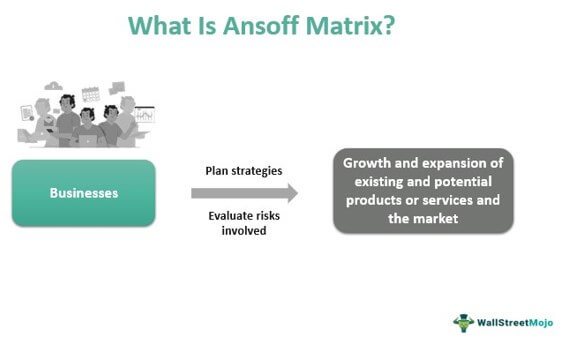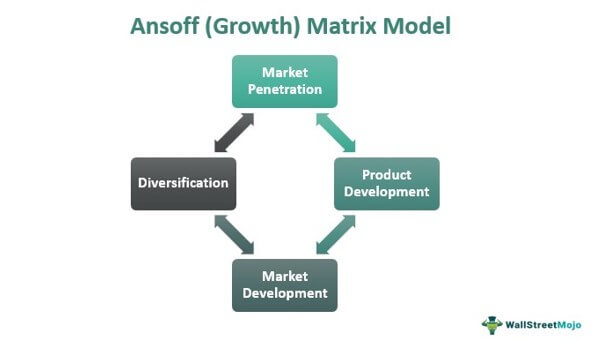Ansoff Matrix Definition
The Ansoff Matrix is a strategic planning tool used by marketers to develop effective strategies for the growth and expansion of products or services and the market. It also lets businesses evaluate risks associated with the strategy put in place.
Executives and managers use this matrix to plan how to make the new and existing products available to the new and established markets. Also referred to as Corporate Ansoff Matrix and Product/Market Expansion Grid, this model arranges new versus existing offerings in one axis and new versus existing markets in the other. Thus, every quadrant of the Ansoff Growth Matrix identifies a different product-market strategy.
Table of contents

You are free to use this image on your website, templates, etc, Please provide us with an attribution linkHow to Provide Attribution?Article Link to be Hyperlinked
For eg:
Source: Ansoff Matrix (wallstreetmojo.com)
Key Takeaways
- Ansoff Matrix definition refers to a tool for framing effective strategies to ensure product and market growth and expansion.
- Every matrix quadrant – market penetration, product and market development, and diversification – identifies a different product-market strategy. Diversification is the riskiest approach, while market penetration is the least risky.
- Companies can establish these strategies by combining existing and potential products.
- Businesses can use the Ansoff Matrix to examine all of their alternatives, analyze them, calculate the risks, and plan how to make new and existing products available to untapped and established markets.
Ansoff Matrix Theory Explained
The Ansoff Matrix theory first appeared in the article “Strategies for Diversification,” published in the Harvard Business Review in 1957. Developed by a Russian-American business manager and applied mathematician, H. Igor Ansoff, the matrix formed the basis of strategy formulation for marketers and businesses based on new and existing products or services and markets.
Since its introduction, the concept has helped businesses identify growth opportunities and assess risks associated with growth and expansion. As a result, they can prepare backup plans keeping in mind issues that might arise in the long run. In addition, the combination of existing and potential products enables companies to develop unique strategies, such as market penetrationMarket PenetrationMarket penetration is calculated as how much the customers are using the product or service compared to the total market for that product or service.read more, product development, market development, and diversification – collectively known as Ansoff Growth Matrix.

You are free to use this image on your website, templates, etc, Please provide us with an attribution linkHow to Provide Attribution?Article Link to be Hyperlinked
For eg:
Source: Ansoff Matrix (wallstreetmojo.com)
- Market Penetration: It refers to the business strategy adopted or implemented to increase the sale of existing products or services in the established market. It attempts to increase the market shareMarket ShareMarket share determines the company's contribution in percentage to the total revenue generated within an industry or market in a certain period. It depicts the company's market position when compared to that of its competitors.read more for existing offerings without changing them by reaching present and potential customers. The various ways include providing discounts, enhancing promotional campaigns, improving distribution channelsDistribution ChannelsA distribution channel is a network of intermediaries that facilitates product delivery from the manufacturer to the end consumer and transfers payments from the buyer to the producer. In other words, it is the route through which a product travels from the production end to the point of consumption. read more, and acquiring competing brands.
- Product Development – It is a strategy to introduce new products or services to the existing market. The strategy works when firms have complete knowledge about the existing market. They develop new products, considering the requirements of existing and potential customers. Finally, they introduce them in the existing market after performing extensive market research, entering strategic partnerships, or acquiring another brand.
- Market Development – It refers to strategies implemented to introduce existing products or services with minimal development into new markets. The compatibility between the offerings and the market exists if they are suitable for each other. Businesses introduce attractive prices for different products, select new markets within or beyond local borders, cater to new customer segments, add new features to the products, choose new product packaging, adopt new online distribution channels, etc., to make this approach effective.
- Diversification – It includes strategies adopted to introduce new products in a new market. However, it requires researching and developingResearching And DevelopingResearch and Development is an actual pre-planned investigation to gain new scientific or technical knowledge that can be converted into a scheme or formulation for manufacturing/supply/trading, resulting in a business advantage.read more both the market and products. Given the high level of risks involved, the diversification quadrant of the Ansoff Matrix is sometimes referred to as “suicidal cell.” But if implemented successfully, this strategy may result in increased business revenuesRevenuesRevenue is the amount of money that a business can earn in its normal course of business by selling its goods and services. In the case of the federal government, it refers to the total amount of income generated from taxes, which remains unfiltered from any deductions.read more.
Market penetration is the least dangerous strategy in the Ansoff Matrix Model, while diversification is the riskiest. Therefore, companies must conduct extensive research to analyze the risks and develop a fail-safe backup strategy.
Financial Modeling & Valuation Courses Bundle (25+ Hours Video Series)
–>> If you want to learn Financial Modeling & Valuation professionally , then do check this Financial Modeling & Valuation Course Bundle (25+ hours of video tutorials with step by step McDonald’s Financial Model). Unlock the art of financial modeling and valuation with a comprehensive course covering McDonald’s forecast methodologies, advanced valuation techniques, and financial statements.
Ansoff Matrix Examples
Let us take a look at Ansoff Matrix with examples to understand each of the strategies:
Example #1 (Market Penetration)
Fast food restaurants operate in the same market, and hence, their target customers are the same. Let us assume restaurant A has more customers than B. The former can have a unique menu or discounted price, or maybe it keeps open 24/7, which the latter does not do to attract new customers. This way, restaurant A would have a larger market share for their existing products and services.
Example #2 (Product Development)
An electric vehicle manufacturer announces to roll out hybrid automobiles in a city. It is also in line with the local government’s initiative to ensure effective transportation electrification at a lenient cost. Furthermore, this announcement marks the introduction of a new product into the already existing automobile market to make transportation eco-friendly in the city.
Example #3 (Market Development)
The e-commerce firm Amazon, Inc. decided to set up a brick-and-mortar store in the United States. However, even though the brand has built a reputation for itself in the online shopping sector, its struggles could be observed given the physically operating competitors in the market. Hence, for Amazon, establishing itself in the new market with products existing in its online store might take time.
Example #4 (Diversification)
Maria is in the food industry, and her outlets are doing great. However, she plans to start a textile business with an entirely new market segment to target. Doing so may involve a high degree of risk as Maria is completely new concerning the products she will be dealing with and the market she is planning to enter.
Uses
Ansoff Matrix is a strategy-based decision-making tool that makes businesses examine their options based on the product and market they are targeting. They can also analyze the risks involved and then decide which way to proceed. Here is how the Ansoff Matrix helps the corporate sector:
- It lets companies understand the product/market strategy to be opted for.
- Once the strategy to be implemented is known, the parameters to be analyzed to make the approach effective are identified.
- The risks associated with the product and market segmentation are assessed as soon as the strategies are formulated concerning the approach and parameter.
- Accordingly, firms decide whether to proceed with the plan.
- Companies can also prepare backup plans if they choose to stick to their decisions.
Frequently Asked Questions (FAQs)
The Ansoff Matrix is a tool that helps businesses develop and implement efficient product and marketing strategies. This model, also known as the Product/Market Expansion Grid, compares new and current offerings on one axis with new and existing markets on the other. As a result, each matrix quadrant suggests a unique growth approach.
The four Ansoff growth strategies include:
– Market Penetration (to increase the sale of existing products in the existing market)
– Product Development (to introduce new products to the existing market)
– Market Development (to introduce existing products into new markets)
– Diversification (to introduce new products in a new market)
Businesses can use the Ansoff Matrix to evaluate product development or market entry choices, assess risks, and select which path to take. It is a strategy-based decision-making tool that allows companies to consider their options based on the product and market they are targeting.
Recommended Articles
This has been a guide to Ansoff Matrix and its definition. Here we explain how Ansoff Matrix theory works along with examples and uses. You may learn more about finance from the following articles –

